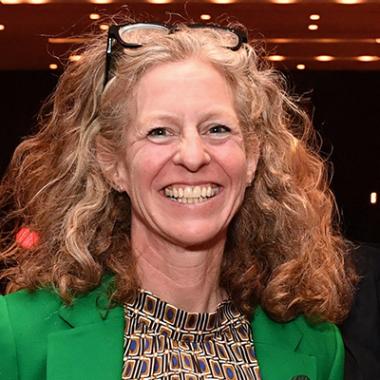About me
Kate Cheyne is Head of Westminster School of Architecture and Cities. She was previously Head of the Leicester School of Art, Design & Architecture at De Montfort University and prior to that, DHoS of Brighton’s School of Architecture and Design. Educated at the Glasgow School of Art and the Bartlett, UCL, she worked in architectural practices in London, Israel and Sri Lanka, predominantly focussing on healthcare and housing projects, before co-founding and jointly directing the female-led, award-winning practice, Architects in Residence (AiR). At AiR, Kate led on innovative off-site construction and novel material investigations with timber and textiles. In 2010 Kate worked with Development Workshop France in Haiti, as consultants to Save the Children USA, designing transitional schools that incorporated safer construction methods. She successfully moved her practice knowledge into research and studio-based education, where she uses situated practice and architectural fieldwork to investigate the collective self to untangle the complexities of place-making. The work explores cultural landscapes, natural materials, rural industries, community networks, traditions, customs and folklore. A particular focus has been with an inter-disciplinary research group evaluating the textile industry and the potential for novel woven materials within the built environment to sense strain.
Kate is an experienced leader in Higher Education with a demonstrated history of forming and leading architecture, art & design schools through periods of significant change. She has led on curriculum transformation, developing and revalidating whole School programmes, including transnational education partnerships. She used these projects to embed ethical and regenerative understanding to underpin a contemporary practice of thinking through doing. She retains external practice-based links through her work on Planning Design Review Panels and Architecture Award Panels, including the 2022 RIBA Honours Committee. She is a member of the Standing Conference of Schools of Architecture (SCOSA), chairs RIBA Validation Boards for UK based and international visits. She is an invited external examiner in a number of institutions ensuring she remains ahead of academic trends within the subject of Architecture, and is currently chairing the update and rewrite of the QAA Subject Benchmark Statement for Architecture.
Teaching
Kate leads the School in delivering a research-led education, where practices of rigorous enquiry permeate every part of what is undertaken. The school is always looking for opportunities where staff research can nourish the teaching and where teaching can enrich the research culture. Research undertaken by full time academics and part-time practitioners infuses the curriculum with current and emerging ideas and knowledge. The design studios, for example, are laboratories driven by tutors’ personal research agendas, which prioritise learning through active discovery rather than passive study. There is a potential benefit for both academic and student when the content being taught is fresh and is relevant to the academic, who will gain an opportunity for intellectual reflection through the students work. The opportunities for cross-disciplinary engagement inherent within the School’s make up are embraced through crossovers in student reviews, symposia and open lecture series by both staff and practitioners, exposing students to the wider School’s research culture.
The School believes that discovery-led education is deeper and more durable than conventional didactic methods. Students are offered the opportunity to co-create their curriculum, determining their research focus. For example, students may evolve their own design project brief, dissertation subject area or technology report focus within the context of a framework brief. This approach brings with it the opportunity for project work to become personally meaningful to the student, fostering intrinsic motivation and deep learning.
The School has a long lineage of live projects that offer students the opportunity for hands-on learning and experience in their disciplines. Practice is brought right to the heart of teaching with a strong contingent of part-time practitioners forming a key part of the design studio teaching team. This is a key component of our pedagogical approach, with its ambition to mimic the professional environment and evolve work under the guidance of skilled practitioners.
Kate’s own design studio stated that the definition of ‘place’ is central to an architecture that is not only successful as a visual object but also effective in responding to how we occupy space and affect the surrounding environment. Sites were real and multiple fieldtrips were set so students continuously returned to place. Students were encouraged to understand their role as relational rather than solitary, and position themselves within a network of users and needs. This allows them to interprete site as something constantly transformed and renegotiated, so that the definition of place becomes open ended rather than singular.
Research
Kate’s research interests have developed out of her fifteen years in architectural practice leading on the use of prefabricated building systems combined with spatial and material innovation. Having worked in a diverse multi-disciplinary studio, from fashion designers to structural engineers and furniture makers to steel fabricators, she learnt the value of interdisciplinary thinking to evolving new design processes that can lead to alternative social and architectural propositions.
Kate's research continues to explores novel materials alongside place and cultural landscapes. She has published on smart woven textiles for structural health monitoring systems. Her interests in place-making and the collective self, support small town traditions like the World Pea Throwing Championship at the Lewes Arms Pub, where she is on the Games Committee.
Much of her design research has dealt with the possibilities of textiles as a viable building material (Tresses, 2009, Fabrikate, 2010, Seismic Shifts, 2011-2017, Strung Out, 2016). Within her teaching she embeds her research that addresses Cultural Landscapes, in particular, the relationship between local materials, growth of rural manufacture and vibrant rural communities (Haiti, 2010, ‘The Isle of Slingers’ 2013, ‘Ducks-a-dabbling’, 2014, ‘Village Factory’ 2014, ‘Blueprints for Future Factories’, 2017, ‘The Makers’ Nursery’, 2018). Kate’s material investigations, in collaboration with Glenn Longden-Thurgood, have tested as full scale prototype structures, through students’ End of Year Show (Rammed Chalk, 2011, Bent Coppiced Beams, 2012, Reciprocating Grid Structures, 2013, Bundled & Lashed Joints, 2017).
